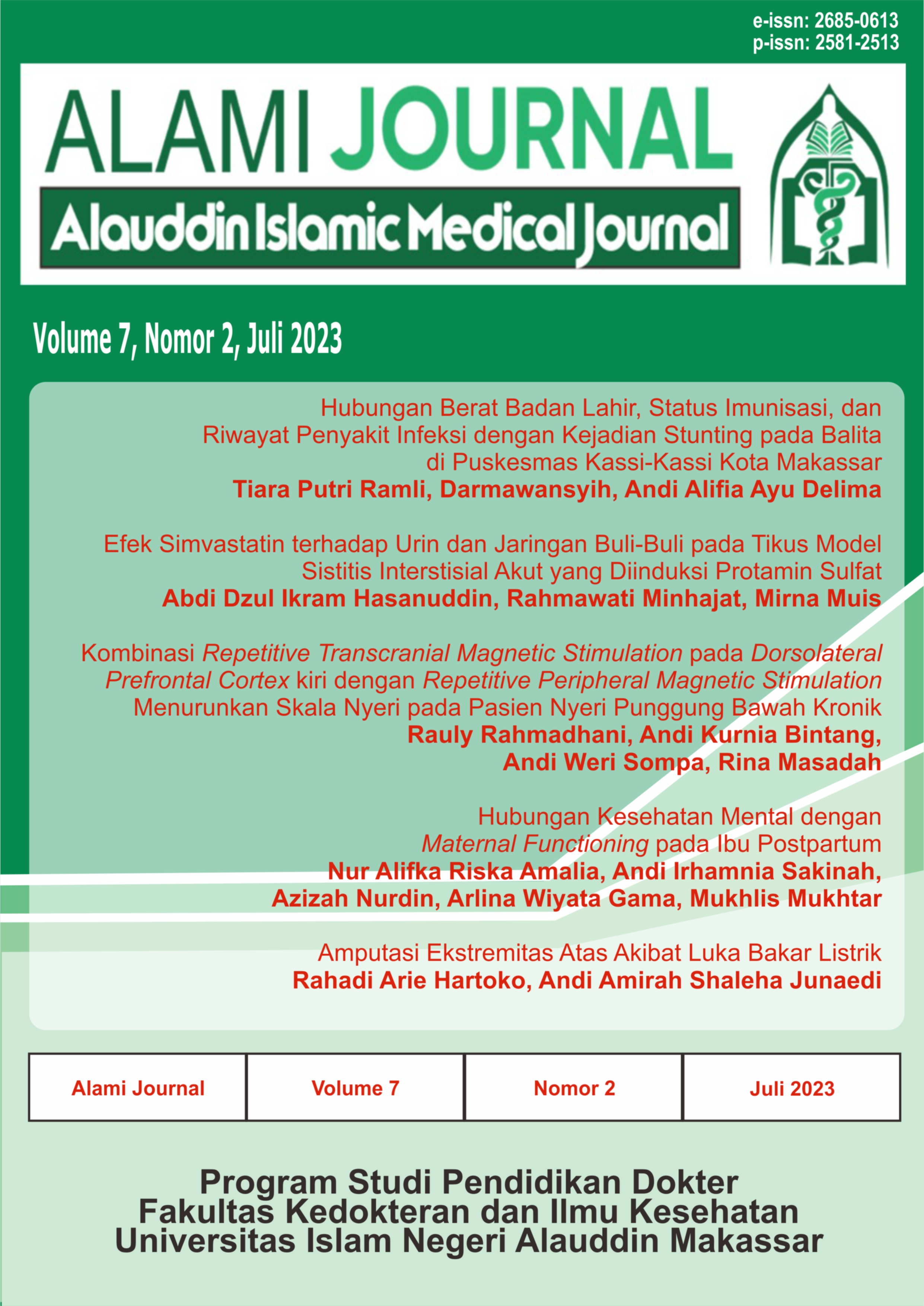Kombinasi Repetitive Transcranial Magnetic Stimulation pada Dorsolateral Prefrontal Cortex kiri dengan Repetitive Peripheral Magnetic Stimulation Menurunkan Skala Nyeri pada Pasien Nyeri Punggung Bawah Kronik
Abstrak
Prevalensi nyeri punggung bawah kronik (NPBK) masih tinggi, saat ini belum ada pengobatan farmakologis yang efektif dengan efek samping yang minimal apabila dikonsumsi dalam jangka panjang sedangkan pengobatan NPBK pada umumnya membutuhkan pengobatan nyeri jangka panjang. Penelitian ini bertujuan menilai pengaruh intervensi kombinasi repetitive Transcranial Magnetic Stimulation ( rTMS) dan repetitive Peripheral Magnetic Stimualtion (rPMS) terhadap perubahan skala nyeri pada pasien nyeri punggung bawah kronik. Jenis penelitian adalah studi eksperimental menggunakan consecutive sampling yang dibagi secara acak menjadi dua kelompok. Kelompok perlakuan mendapat pengobatan farmakologis dan terapi intervensi rTMS dan rPMS selama dua minggu, kelompok kontrol hanya diberikan pengobatan farmakologis. Pengukuran skala nyeri dilakukan pada kedua kelompok pada hari pertama, ke-enam, dan hari ke-tiga belas. Hasil penelitian menunjukan terdapat perbedaan penurunan nyeri yang signifikan antara kelompok perlakuan dan kelompok kontrol. Penurunan skala nyeri pada kelompok perlakuan jauh lebih besar dengan nilai mean -6.07 dibanding kelompok kontrol nilai -3.00, signifikan dengan nilai p 0.001. Setelah 10 kali sesi intervensi kombinasi rTMS dan rPMS terdapat pengaruh terhadap penurunan skala nyeri pada pasien nyeri punggung bawah kronik.
Referensi
Freigang S, Lehner C, Fresnoza SM, Mahdy Ali K, Hlavka E, Eitler A, et al. Comparing the Impact of Multi-Session Left Dorsolateral Prefrontal and Primary Motor Cortex Neuronavigated Repetitive Transcranial Magnetic Stimulation (nrTMS) on Chronic Pain Patients. Brain Sciences, 2021 Jul 22;11(8):961.
PERDOSSI. Panduan Praktis Klinis Neurologi. JAKARTA; 2016.
Chou R, Huffman LH. Medications for Acute and Chronic Low Back Pain: A Review of the Evidence for an American Pain Society/American College of Physicians Clinical Practice Guideline. Annals of Internal Medicine. 2007 Oct 2;147(7):505.
Marcum ZA, Hanlon JT. Recognizing the Risks of Chronic Nonsteroidal Anti-Inflammatory Drug Use in Older Adults. The Annals of Long-term Care: the official journal of the American Medical Directors Association, 2010;18(9):24-7.
Yang S, Chang MC. Effect of Repetitive Transcranial Magnetic Stimulation on Pain Management: A Systematic Narrative Review. Frontiers in Neurology, 2020 Feb 18;11:114.
Vielsmeier V, Schecklmann M, Schlee W, Kreuzer PM, Poeppl TB, Rupprecht R, et al. A Pilot Study of Peripheral Muscle Magnetic Stimulation as Add-on Treatment to Repetitive Transcranial Magnetic Stimulation in Chronic Tinnitus. Frontiers in Neuroscience, 2018 Feb 20;12:68.
Beam W, Borckardt JJ, Reeves ST, George MS. An efficient and accurate new method for locating the F3 position for prefrontal TMS applications. Brain Stimulation, 2009 Jan;2(1):50–4.
Rustin Berlow, Volcani D. Location of F3: Comparing Calculated (Beam F3 Method) to Empirical (6cm Method) for Optimal TMS Coil Placement (Dorsolateral Prefrontal Cortex) [poster]. 2015.
Ong WY, Stohler CS, Herr DR. Role of the Prefrontal Cortex in Pain Processing. Molecular Neurobiology, 2019 Feb;56(2):1137–66.
Seminowicz DA, Moayedi M. The Dorsolateral Prefrontal Cortex in Acute and Chronic Pain. The Journal of Pain, 2017 Sep;18(9):1027–35.
Apkarian VA, Hashmi JA, Baliki MN. Pain and the brain: Specificity and plasticity of the brain in clinical chronic pain. Pain, 2011 Mar;152(3):S49–64.
Moretti J, Poh EZ, Rodger J. rTMS-Induced Changes in Glutamatergic and Dopaminergic Systems: Relevance to Cocaine and Methamphetamine Use Disorders. Frontiers of Neuroscience, 2020 Mar 6;14:137.
Biernacki K, Myers CE, Cole S, Cavanagh JF, Baker TE. Causal effects of prefrontal transcranial magnetic stimulation on dopamine-mediated reinforcement learning in healthy adults. Biorxiv, 2022 Jun.
Lim YH, Song JM, Choi EH, Lee JW. Effects of Repetitive Peripheral Magnetic Stimulation on Patients With Acute Low Back Pain: A Pilot Study. Annals of Rehabilitation Medicine, 2018;42(2):229.
Altas EU, Askin A, Beşiroğlu L, Tosun A. Is high-frequency repetitive transcranial magnetic stimulation of the left primary motor cortex superior to the stimulation of the left dorsolateral prefrontal cortex in fibromyalgia syndrome?. Somatosensory and Motor Research, 2019 Jan 2;36(1):56–62.
Che X, Cash RFH, Luo X, Luo H, Lu X, Xu F, et al. High-frequency rTMS over the dorsolateral prefrontal cortex on chronic and provoked pain: A systematic review and meta-analysis. Brain Stimulation, 2021 Sep;14(5):1135–46.
Badawy RAB, Tarletti R, Mula M, Varrasi C, Cantello R. The routine circular coil is reliable in paired-TMS studies. Clinical Neurophysiology, 2011 Apr;122(4):784–8.
Ho Chae, Jeong, Kim, Won, Myong Bahk, Won. Repeated Transcranial magnetic Stimulation (rTMS) with Circular Coil for Patients with Treatment Resistant Depression; AN Open Trial. Psychiatry Investigation, 2005;2(1):61–5.
Massé-Alarie H, Beaulieu LD, Preuss R, Schneider C. Repetitive peripheral magnetic neurostimulation of multifidus muscles combined with motor training influences spine motor control and chronic low back pain. Clinical Neurophysiology, 2017 Mar;128(3):442–53.
Ambriz-Tututi M, Alvarado-Reynoso B, Drucker-Colín R. Analgesic effect of repetitive transcranial magnetic stimulation (rTMS) in patients with chronic low back pain: rTMS Effect in Patients With Low Back Pain. Bioelectromagnetics, 2016 Dec;37(8):527–35.
##submission.copyrightStatement##
##submission.license.cc.by-nc-sa4.footer##Once an article was published in the journal, the author(s) are: granted to the journal right licensed under Creative Commons License Attribution that allows others to share the work with an acknowledgement of the work's authorship. permitted to publish their work online in third parties as it can lead wider dissemination of the work. continue to be the copyright owner and allow the journal to publish the article with the CC BY-NC-SA license receiving a DOI (Digital Object Identifier) of the work.

